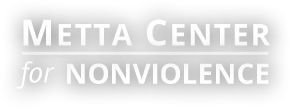MPT's report on the Creation of the Shanti Sena Network
Nonviolence Home › Forums › shanti sena network › MPT's report on the Creation of the Shanti Sena Network
Tagged: MPT, nonviolence, peace teams, Shanti Sena Network, SSN, training
- This topic has 0 replies, 1 voice, and was last updated 12 years, 8 months ago by
Erika.
-
AuthorPosts
-
November 15, 2012 at 11:13 am #9809
Erika
MemberCreation of the Shanti Sena Network:
Sept. 14-16, 2012 at the Whitefeather Peace Community in Portland, ORThis gathering was dedicated to the memory and work of Plowshares Peace Activist Sister Anne Montgomery (b. November 30, 1926; d. Aug. 27, 2012).
As seventeen nonviolence skills trainers from across the United States and Canada gathered for this collaborative meeting, certain things became immediately clear. First among these is that we need to change the national conversation from one that is war and retaliation based to one that is nonviolent and justice based: Create a true paradigm shift.
Part of what we determined is needed to begin this process is some sort of national notification system: When trained local (a.k.a., “domestic”) peace teams are being called for and scheduled to be placed, we need to have an effective network to “get the word out”…Thus creating the Shanti Sena Network (SSN), with The Metta Center in Petaluma, California acting as the clearing house and/or “hub” for this network. The ideal here is that, if we can expand and improve our networking, we can increase the momentum behind and – in the end – more readily achieve the paradigm shift we’re seeking. The original Shanti Sena (Sanskrit for Peace Army) was the ultimate dream of renowned peacemaker Mahatma Gandhi.
From a practical standpoint, we agree it’s crucial to (as much as is possible) incorporate all five senses into the learning process when training potential peace team participants. Realism is imperative to effective preparedness training.
From a more philosophical perspective, we also need to tackle, from the onset, one of the biggest fallacies that Americans buy into: the illusion of our separateness from – – and our lack of interdependence upon – – one another. This myth, and the accompanying “us/them” mentality, allows for the development of six powerful social evils:
(Insert “Separateness” graphic here)
The U.S. is the great perpetrator of this kind of propaganda, including a doctrine that when we’ve been victimized, we need to strike back. As these evils of separateness are perpetuated, so is the illusion that we have no part in collectively solving or curtailing them: We surrender the resolution of these ills to our current dysfunctional structures (i.e., Since our culture does not prepare us with the skills to deal with conflict ourselves, we rely on the police and military to deal with conflict for us.). The police and military have thus become our formalized, justified, and “legitimate” forms of violence. What we – the Shanti Sena Network – want to do is institutionalize nonviolence as the societal “go-to” approach:
(Insert “WheelofNV” graphic here)
Before dismantling the current structures that are in place, we must be prepared to offer a strong, viable, effective alternative. We must be able to deploy prepared, trained, supplied peace teams as fast as the police can deploy their officers to a crime scene or the military can deploy their troops to the front lines. We must also acknowledge that peace teams are not the whole peace movement, but merely an important slice of the pie…The other portions of the peace movement remain as important as ever. Additionally, we must step out of the polarization mindset so prevalent in our society (us/them, good/bad, right/wrong) if we are truly to be collaborative and cooperative in nature. This new model will thus aid in curtailing the current promulgation of the evils of separateness:
Sat, at the center of it all – as depicted in the above diagram – replaces the unreality of our separateness with the reality of interconnectedness, with truth (as opposed to falsehoods), and with goodness (as opposed to that which is harmful and negative). This new paradigm emphasizes that we are all one.
Education is paramount to this. As Victor Hugo said, “He who opens a school door, closes a prison.” On many levels, education is a huge deterrent to violence. To paraphrase Abraham Maslow, “If the only tool in your toolbox is a hammer, every problem looks like a nail”. Therefore, it becomes our job – as peace and nonviolence educators – to teach as many alternative tools of nonviolence as we can…to get as many tools into that toolbox as possible. And not only must we expand the public’s repertoire of available tools, but also the ways in which they are able to acquire them: In this case, workshops and training seminars, but also publications and webinars, message boards and blogs, print media and video, audio files, Wikipedia, and handouts (etc., to name but a few).
With this vision in mind, the Shanti Sena Network will plan to meet (at least initially) four times per year: two face-to-face meetings (one in the Spring, one in the Fall), and alternately two ‘virtual’ meetings via Skype (Summer and Winter).
Identified facets of concentration and follow-up for the Shanti Sena Network include:
(Insert “SSN” graphic here)
Outreach & Recruiting: How do we inform others of our existence? Encourage them to join us? One suggestion, as a starting point, is to create an introductory video explaining TPNI (Third Party Nonviolent Intervention) that would be available for wide distribution. Another idea is to identify and contact peace & justice groups to offer regional trainings. Additionally, we may want to find opportunities to participate in community projects, making us more visible to the public at large. While strengthening bonds with our teammates, this also creates an opportunity for the communities in which we live to identify us as an asset. As best as is possible, we need to write and get published articles on our work & successes. Get the word out!!!
Funding: We need to identify alternative funding sources, and then find effective ways of inviting their participation and financial support.
Resources: Develop message boards, dialogue opportunities, information sharing, and libraries of information for SSN members. Resources should include books, articles, videos & films, and speakers. We also need to develop a Core Curriculum, with identified competencies, that helps ensure well-trained peace team members.
S.O.S. Mobilization: Create phone trees, listserv(s), texting lists, etc. to mobilize SSN members in case of an emergency, based on the development of a database of pertinent information (contact information/experience level/ability to travel/etc.).
Media: Utilize independent media sources, post to PeaceVoice, investigate a standing column in Waging Nonviolence, and optimize social networking. We need to do well-written press releases (with accompanying photos and/or video clips of our actions, when possible) and get these out to new and alternative media sources.
Relationship Building: SSN members commit to meeting on a regular basis – – Face-to-face in the Spring and Fall; virtually via Skype in the Summer/Winter. Discuss the possibility of annual regional meetings as well.
Additionally, we need to put a real emphasis on continuing our centering work: When we consistently practice finding our “core” – the place inside of us where we are our highest self – we are more readily able to get to this place when tested in times of turmoil. When things become most chaotic, we will more readily be able to access our best/highest self to work from, having practiced this path on a regular basis. This, too, is an important tool for peace team members to have at their fingertips. Thich Nhat Hanh, encouraging people to take up the practice of centering/meditating, said “I am inviting you to go deeper, to learn and to practice so that you become someone who has a great capacity for being solid, calm, and without fear, because our society needs people like you who have these qualities, and your children, our children, need people like you, in order to go on, in order to become solid, and calm, and without fear.”
Recommendations for Peacemakers – Michael Naglar
· We must limit our exposure to violent imagery so that we never become desensitized to it and so that it does not become part of us . Mass media downgrades the human image. When we are sensitive to basic human suffering, we begin to create a culture of nonviolence.· We need to be personal and personable: Peaceful people need face-to-face time. Be prepared to be of service to whomever enters your door/life. Replace mindless , dehumanizing mass media with a culture of peace.
· Take up a spiritual practice! Meditation is a wonderful tool. You could try “Passage Meditation” (per Eknath Easwaran): Practiced for one-half hour daily on first arising, meditate on a passage from a book or poem or letter, then repeat a mantram (mantra, or prayer word) that springs from that passage. Or you could develop a simple mantra of your own…Gandhi used to repeat “Rama” (which means “Joy”) over and over again. You could try “Meditation for Peacemakers” by Michael Naglar (available here: http://www.lulu.com/shop/michael-nagler/meditation-for-peacemakers/ebook/product-20140595.html). Investigate Nonviolence for Daily Living (a Metta Center blog). What is most important is that we must never underestimate the power of centering.
· We want peace teams to be seen as a part of our culture. Not as a profession, but as a way of life.
· We need to make all of our work about elevating the human image, not tearing it down.
· We are not about eliminating anger – – Anger in response to injustice should be an imperative! But we must stop talking about anger management (which usually means suppression) and instead talk about anger conversion – – using the energy and power behind our anger as a tool and force for good; to have it be a constructive energy to strengthen our bonds of interconnectivity, interdependence, and wholeness.
In Summary
“I offer you peace. I offer you love. I offer you friendship. I see your beauty. I hear your need. I feel your feelings. My wisdom flows from the Highest Source. I salute that Source in you.
Let us work together for unity and love.”
– Mahatma GandhiP
eacemakers from around the United States and Canada met collectively for the first time to discuss the possibilities of unifying, strengthening, and networking our efforts. By the end of this gathering, some things were abundantly clear:
We need to change the national conversation from one that is war and retaliation based to one that is nonviolent and justice based.
We need to actively confront the illusion of our separateness from one another.
We must be prepared to offer a strong, viable, effective alternative to violence if we are to turn the tide.
We must be able to deploy prepared, trained, supplied peace teams as fast as the police can deploy their officers to a crime scene or the military can deploy their troops to the front lines.
As peace and nonviolence educators, we must teach as many alternative tools of nonviolence as we can, using as many different avenues & methods of teaching as we can, to put these tools into the hands of any-and-everyone interested.
We need to document and disseminate the stories of our work & successes using words, pictures, and video. We must take full advantage of independent (a.k.a., “Indy”) media. The public cannot gain interest in something it is not hearing about.
We must maintain the emphasis on our centering work as part of our training: When things become most chaotic, we will more readily be able to access our best/highest self to work from if we’ve consistently practiced the path to getting there.
Our first step in solidifying the above aspirations is the creation of this Shanti Sena Network. We will continue to work together to bring about this paradigm shift, collectively striving to establish the most effective training curriculum and networking of concerted efforts for replacing violence (whether individually perpetrated or state sponsored) with nonviolence, reparation, and reconciliation.
In closing, we offer this personal pledge of nonviolence, inspired by the teachings of Mahatma Gandhi:
Pledge of Nonviolence
To Respect Self and OthersTo respect myself, to affirm others and to avoid uncaring criticism, hateful words, physical attacks and self-destructive behavior.
To Communicate Better
To share my feelings honestly, to look for safe ways to express my anger, and to work at solving problems peacefully.
T0 Listen
To listen carefully to one another, especially those who disagree with me, and to consider others’ feelings and needs rather than insist on having my own way.
To Forgive
To apologize and make amends when I have hurt another, to forgive others, and to keep from holding grudges.
To Respect Nature
To treat the environment and all living things, including our pets, with respect and care.
To Play Peacefully
To select entertainment and toys that support nonviolence and to avoid entertainment that makes violence look exciting, funny or acceptable.
To Be Courageous
To challenge violence in all its forms whenever I encounter it, whether at home, at school, at work, or in the community, and to stand with others who are treated unfairly.
This is my pledge. These are my goals.
Respectfully Submitted,
Mary L. Hanna
Sheri Wander
Elliott AdamsMembers of Michigan Peace Team
-
AuthorPosts
- You must be logged in to reply to this topic.







